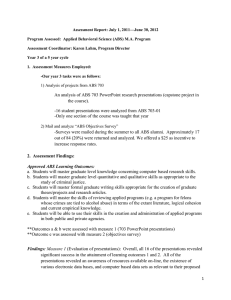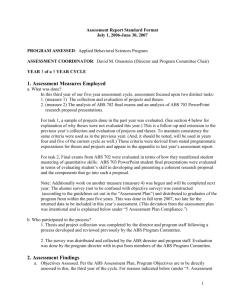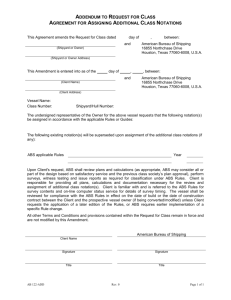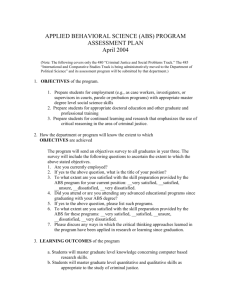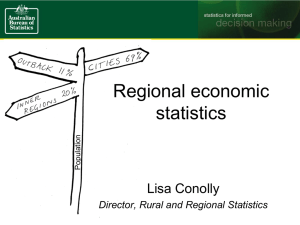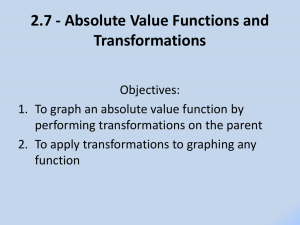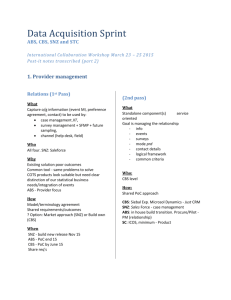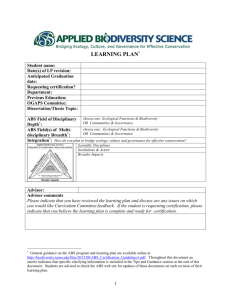Applied Behavioral Science (M.A.)
advertisement
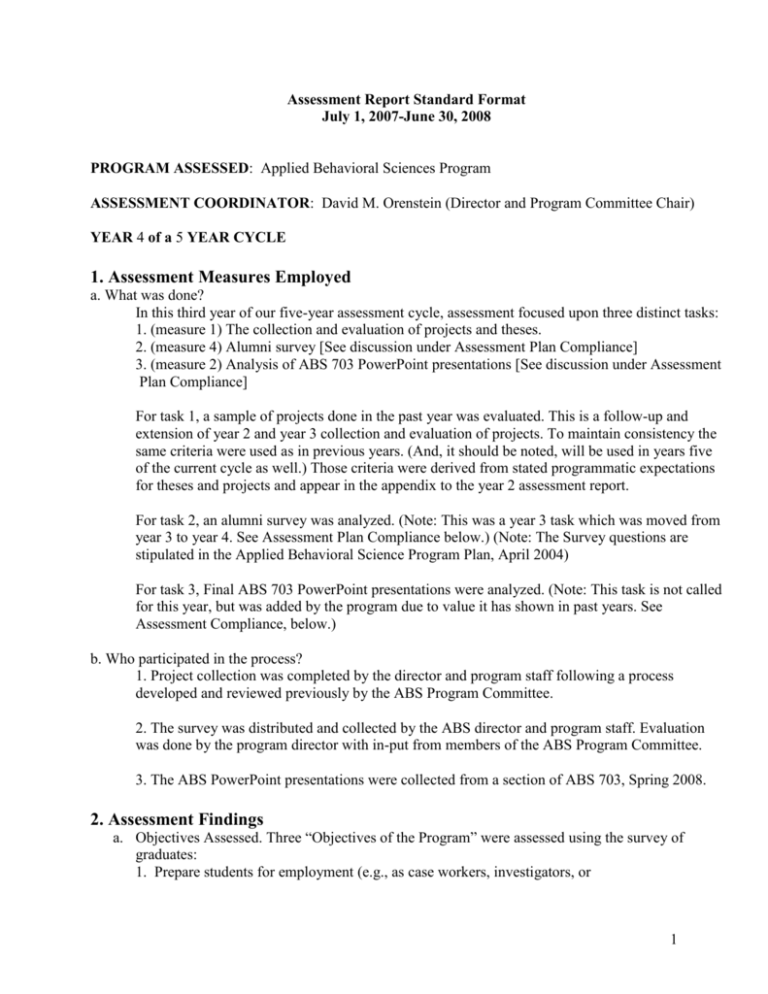
Assessment Report Standard Format July 1, 2007-June 30, 2008 PROGRAM ASSESSED: Applied Behavioral Sciences Program ASSESSMENT COORDINATOR: David M. Orenstein (Director and Program Committee Chair) YEAR 4 of a 5 YEAR CYCLE 1. Assessment Measures Employed a. What was done? In this third year of our five-year assessment cycle, assessment focused upon three distinct tasks: 1. (measure 1) The collection and evaluation of projects and theses. 2. (measure 4) Alumni survey [See discussion under Assessment Plan Compliance] 3. (measure 2) Analysis of ABS 703 PowerPoint presentations [See discussion under Assessment Plan Compliance] For task 1, a sample of projects done in the past year was evaluated. This is a follow-up and extension of year 2 and year 3 collection and evaluation of projects. To maintain consistency the same criteria were used as in previous years. (And, it should be noted, will be used in years five of the current cycle as well.) Those criteria were derived from stated programmatic expectations for theses and projects and appear in the appendix to the year 2 assessment report. For task 2, an alumni survey was analyzed. (Note: This was a year 3 task which was moved from year 3 to year 4. See Assessment Plan Compliance below.) (Note: The Survey questions are stipulated in the Applied Behavioral Science Program Plan, April 2004) For task 3, Final ABS 703 PowerPoint presentations were analyzed. (Note: This task is not called for this year, but was added by the program due to value it has shown in past years. See Assessment Compliance, below.) b. Who participated in the process? 1. Project collection was completed by the director and program staff following a process developed and reviewed previously by the ABS Program Committee. 2. The survey was distributed and collected by the ABS director and program staff. Evaluation was done by the program director with in-put from members of the ABS Program Committee. 3. The ABS PowerPoint presentations were collected from a section of ABS 703, Spring 2008. 2. Assessment Findings a. Objectives Assessed. Three “Objectives of the Program” were assessed using the survey of graduates: 1. Prepare students for employment (e.g., as case workers, investigators, or 1 supervisors in courts, parole or probation programs) with appropriate master degree level social science skills 2. Prepare students for appropriate doctoral education and other graduate and professional training 3. Prepare students for continued learning and research that emphasizes the use of critical reasoning in the area of criminal justice. b. Learning Outcomes Assessed this Year: b. Students will master graduate level quantitative and qualitative skills as appropriate to the study of criminal justice. c. Students will master formal graduate writing skills appropriate for the creation of graduate theses/projects and research articles. c. Findings Findings for Program Objectives: Based on a survey of graduates, all three Objectives of the Program have been met: 1. The survey revealed that students who had employment in criminal justice related fields and who had graduated from ABS in recent years were either satisfied or very satisfied with the level and type of preparation they received in the program. (Those few who expressed some level of dissatisfaction had graduated before the current requirements were put into place.) 2. Those few students who went on to doctoral-level and other professional degree programs indicated that they were highly satisfied with the education they had received in the ABS Program. 3. Based on a response to an open-ended question concerning the use of critical reasoning, We conclude that graduates did use critical reasoning skills acquired in the ABS program in later careers and educational activities. Findings for Learning Outcomes. b. - Students will master graduate level quantitative and qualitative skills as appropriate to the study of criminal justice. Measure 1 – Review of projects showed this goal was met. Students were able to make appropriate use of quantitative and qualitative methodologies. Measure 2PowerPoint presentations from ABS 703 indicate the appropriate ability to interpret integrate qualitative and quantitative materials into the research process. Both measure 1 and 2 reveled a degree of increased methodological sophistication over past years. c. - Students will master formal graduate writing skills appropriate for the creation of graduate theses/projects and research articles. Measure 1 - Review of projects show this goal was met. Most projects are written in the form of journal articles and demonstrate that students can write in a style and format appropriate for such articles. Measure 2 –PowerPoint presentations from ABS 703 indicate the appropriate ability to write about research, its results and its significance. Explanation of project evaluation used in the evaluation of learning outcomes b and c. 2 Evaluation of nine final projects dating from the current assessment year indicated substantial success in attainment of learning outcomes a and b. Minor grammatical and spelling errors and labeling of charts and graphs that were noted in past years seem to have been reduced to an insignificant few. Other results paralleled last two years: No significant problems appeared in students’ ability to show use of quantitative or qualitative data in a manner generally acceptable in the social sciences, state a clear research question or hypothesis, and appropriately construct the general elements expected in work reporting on applied research (title, abstract, literature review, and implications of findings). Explanation of ABS 703 PowerPoint presentations used in the evaluation of learning outcomes b and c. The PowerPoint presentation was formalized this year. Each student was given the same sixteen slide titles and guidelines for the material to be included. Students were evaluated on the ability to state the elements of appropriate research design, the application of that design to a particular coherent research question, and the overall clarity and integration of presentation. 3. Program Improvements Though the results of the data indicate that no significant program revisions were necessary, they remind the Program Committee of the goals of the program that must be taken into account as new methodologies are incorporated into the program. 4. Assessment Plan Compliance For measure #1: Once again only projects were looked at this year due to an insufficient number of theses from which to draw a sample. This is the third year this has occurred. The ABS Program Committee will review suggesting an appropriate change in the ABS Assessment Plan. For measures #4 and #3: Measure #4, the “Objectives Survey” was moved from year three to year four as noted in last year’s section on Assessment Plan Compliance. In that the findings from measure #4 will be used in the graduate focus group analysis, that analysis (measure #3) will be moved from this year (year 4) to next year (year 5). For measure # 2: The PowerPoint analysis in measure #4 has proved fruitful in past years and though not required in year four a decision was made to continue its usage this year. 5. New Assessment Developments N/A 3
